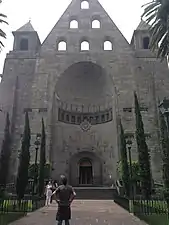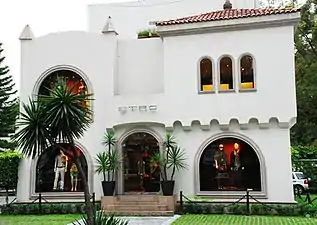Polanco, Mexico City
Polanco is an affluent neighborhood in the Miguel Hidalgo borough of Mexico City. Polanco is an upscale community, famed for its luxury shopping on Avenida Presidente Masaryk, one of the most expensive streets in the Americas, as well as for the numerous prominent cultural institutions located within the neighborhood, such as the Museo Soumaya and the Colección Jumex.[1] Polanco is often called the "Beverly Hills of Mexico",[2][3][4][5] having one of the country's densest concentrations of luxury shopping, with the most Michelin star restaurants, high-net-worth individuals, upscale hotels, and diplomatic missions and embassies. Additionally, it is one of the most desirable real estate markets in Latin America.[6]
Polanco | |
|---|---|
.jpg.webp) .jpg.webp)  _(cropped).jpg.webp) | |
 Polanco Location of Polanco in Central/Western Mexico City | |
| Coordinates: 19°26′N 99°12′W | |
| Website | http://www.polanco-online.com.mx |
History
.jpg.webp)
The colony takes its name from a river that crossed what is now the Avenue Campos Elisios (Champs Elysees), named in memory of the Spanish Jesuit Juan Alfonso de Polanco, a secretary of Ignatius of Loyola, whose relatives, members of the Polanco family, were members of board of the Kings of Spain in the 17th century and came to Mexico as officers of the Crown.
In a plan made by Francisco Antonio Guerrero y Torres and dated 1784, a "ruined house Polanco" is located on the grounds of the Hacienda de San Juan de los Morales. This hacienda sits on land donated in the sixteenth century to Hernán Cortés by the King of Spain, under the jurisdiction of Tacuba. At the beginning of the colonial times, parts of this land (near the current center of the Hacienda) were occupied for planting mulberry trees for breeding silkworms (hence the name "los morales"). The hull of the Hacienda as currently known dates from the eighteenth century. Extension lands belonging to the estate began to be divided in the late 1920s.
Polanco was developed in 1937 by the Aleman family, the same developers of Ciudad Satélite and San José Insurgentes districts, on the land that was originally the Hacienda de los Morales, just north of Molino del Rey town and Bosque de Chapultepec. The first area to be built is now called Polanco Reforma and lies just north of Paseo de la Reforma, the entrance to the new neighborhood marked by a tile obelisk facing Reforma. In those days, there were only mansions surrounded by gardens and tree lined streets.
By the 1960s, the first department store arrived in the neighborhood, forever transforming the face of Polanco. In the 1970s, the last piece of land to be developed was sold, the triangle of Ejército Nacional, Ferrocarril de Cuernavaca and Periférico, where no stand-alone housing was built, only apartment buildings.
The 1985 earthquake reshaped the city layout, and Polanco was no exception; restaurants, embassies, boutiques and corporate business slowly moved from Zona Rosa and found a great new home in Polanco. Big houses were torn down and replaced with new buildings. The former inhabitants typically moved to neighborhoods such as Bosques de las Lomas and Lomas de Tecamachalco.
Today Polanco is facing a challenge. Land prices are some of the most expensive in the city, as zoning rules forbid skyscrapers in the area. There are few big mansions remaining which are protected by INBA, therefore large building projects cannot be undertaken like the ones in Lomas de Chapultepec, or Santa Fe, two areas which have an edge on attracting new inhabitants. Ruben Dario avenue, facing Chapultepec Park, and Campos Eliseos are two of the most expensive streets in Mexico City, with apartments ranging up to $15 million.
Geography

Polanco consists of five officially recognized colonias, called "Polanco I Sección", "Polanco II Sección", "Polanco III Sección", "Polanco IV Sección", and "Polanco V Sección".[7]
The borders of Polanco are:[7]
- On the north, Avenida Ejército Nacional and the Nuevo Polanco area as well as Colonia Irrigación
- On the south, Paseo de la Reforma
- On the east, Avenida General Mariano Escobedo and Colonia Anzures
- On the west, Blvd. Manuel Ávila Camacho (Anillo Periférico) and the colonias of Lomas de Chapultepec, Reforma Social and Residencia Militar
Formerly Polanco contained nine colonias whose names were: Bosque de Chapultepec, Bosque de Chapultepec Polanco, Chapultepec Morales, Chapultepec Polanco, Los Morales - Sección Palmas, Los Morales - Sección Alameda, Polanco Reforma, Polanco Chapultepec, and Rincón del Bosque.[8]
Polanquito, between Parque Lincoln and Avenida Masaryk, consists of a three by three block pedestrian-friendly area with wall-to-wall restaurants and cafés.[9]
Nuevo Polanco is an area bordering Polanco to the north across Avenida Ejercito Nacional. It contains the Antara Polanco and Plaza Carso shopping malls, two new major museums, and many new residential towers.
Demographics
The population of Polanco is 27,322, distributed as follows across the colonias:[10]
- Zone I: 5,385
- Zone II: 4,943
- Zone III: 3,603
- Zone IV: 3,634
- Zone V: 9,757
Culture

Architecture
Polanco enjoyed a construction boom in the 1950s, when mansions and luxury apartment complexes were built. The style of construction of most mansions of this period is "Colonial Californiano", inspired by the Mission Revival Style in the Southwestern United States, with pseudo-baroque quarry windows, front-side gardens and inside halls. Some of these mansions have been renovated and converted into businesses and restaurants; many others have simply been torn down and replaced with new buildings.
Restaurants
Polanco is home to some of the most famous restaurants in Mexico and Latin America, many of them being Michelin star-rated.
With renowned restaurants like Pujol (Ranked 12th best in the world), Quintonil (ranked 24th best in the world), Biko (Ranked 43 best in the world), Dulce Patria (Ranked 48 best in Latin America), Nobu, Morimoto, Tori Tori, Mr. Chow, Astrid y Gaston, Porfirios, Hacienda de Los Morales and Anatol.
Parks
Part of the city's iconic park, Chapultepec, falls within Polanco's borders. Parque Lincoln is a neighborhood park as are the smaller Parque América and Plaza Uruguay.
Museums
Polanco is walking distance from some of the city's most important museums in Chapultepec Park, such as the National Museum of Anthropology, the Soumaya Museum, the Modern Art Museum and Chapultepec Castle. Bordering Polanco on the north, in Nuevo Polanco are the Museo Soumaya and Museo Jumex.
Economy
.jpg.webp)
In addition to the above-mentioned shopping and dining, Polanco and Nuevo Polanco together are one of the primary areas for Class A office space in the city and metro area. As of 2017 Polanco was the second fastest-growing area of new construction of office space.[11] Samsung, Coca-Cola, Visa, GM, Nestlé, Telmex/Grupo Carso and many more multinationals have their headquarters in the middle of Polanco.
Avenida Presidente Masaryk
The highest-priced street and the one with the most upscale boutiques in Latin America,[12] it is compared by some to Beverly Hills' Rodeo Drive or New York City's Fifth Avenue.[12] The Avenue is named after the first President of Czechoslovakia Tomáš Masaryk.
Shops include Louis Vuitton, Cartier, Chanel, Corneliani, Salvatore Ferragamo, Tiffany & Co., DKNY, Ermenegildo Zegna, Brioni, Burberry, Bulgari, Chopard, Gucci, Hermès, Frette, Marc Jacobs, Max Mara, Hugo Boss, Rolex, Jaeger Le Coultre, Galerias Tehran, and Berger Joyeros.[13]
Department stores
Polanco has a freestanding Liverpool department store, as well as the largest department store in Latin America, the flagship Palacio de Hierro store.[14]
Shopping centers
Shopping centers include:
- Pabellón Polanco, anchored by Sears and Cinemex cinemas
- Pasaje Polanco, originally called simply the Pasaje Comercial, a smaller but historic collection of shops around a courtyard, built in 1938 in Colonial Californiano style (Mexican interpretation of California Spanish Colonial Revival architecture)[15]
Bordering Polanco in Nuevo Polanco are:
- Antara Fashion Hall, anchored by the Casa Palacio home store and Cinemex cinemas
- Plaza Carso, anchored by Saks Fifth Avenue and Cinépolis cinemas
- Galerías Polanco, anchored by West Elm
- Centro Comercial Polanco, anchored by Costco, Chedraui hypermarket and Cinemex cinemas
- Miyana, anchored by Soriana supermarket and Cinépolis VIP cinemas
Transportation
Polanco is bordered on the west by the Anillo Periférico ring road and the Avenida Río San Joaquín freeway is just to the north, connecting the Periférico via Polanco to central Mexico City. Main east-west thoroughfares include (south to north:) Paseo de la Reforma, Avenida Presidente Masaryk, Ave. Horacio, Ave. Homero, and Ave. Ejercito Nacional. Main north-south thoroughfares include (east to west): General Mariano Escobedo, Molière, Ferrocarril de Cuernavaca and Juan Vásquez Mella.
Public transit
Polanco is served by the Polanco and Auditorio stations of the Mexico City metro (subway). The western terminus of the double decker buses of the Reforma line of the Metrobús (bus rapid transit) is in Polanco. Peseros (minibuses), city buses and trolleybuses ply numerous streets in Polanco continuing to and from other parts of the city.
Education
Schools in Polanco include:
- Lycée Franco-Mexicain (Liceo Franco Mexicano)[16]
- Colegio Ciudad de México Plantel Polanco[17]
- Conservatorio Nacional de Música
Gallery
.jpg.webp) Bally Shoe boutique
Bally Shoe boutique.jpg.webp) Casa de Arte
Casa de Arte
 San Agustin Church
San Agustin Church High-end boutique
High-end boutique
 Skyscrapers in Polanco
Skyscrapers in Polanco
See also
References
- Villamil, Valente (23 November 2016). "Masaryk, la tercera avenida más cara en América Latina" [Masaryk, the third-most-expensive avenue in Latin America]. El Financiero (in Spanish). Retrieved 29 May 2020.
- https://www.cntraveler.com/gallery/best-hotels-in-mexico-city
- https://www.forbes.com/sites/bazdreisinger/2019/04/17/five-reasons-to-stay-at-presidente-intercontinental-mexico-city/#10b1b9fa2b78
- Lieber, Sara; Summa, Ann; Monroy, Liza; Spurrier, Jeff; Tavel, Rachel (2007-10-08). MTV Best of Mexico. ISBN 9780764587757.
- Deane, Zain (2011-09-09). Explorer's Guide Mexico City, Puebla & Cuernavaca: A Great Destination (Explorer's Great Destinations). ISBN 9781581579000.
- "Mexico City Neighborhood Guide: Polanco".
- Mapa Colonias [Map of Colonias] (in Spanish), Delegación Miguel Hidalgo, archived from the original on 2013-10-12, retrieved 2013-10-06
- Suárez, Gerardo (2013-07-04), "Aumenta registro de comités vecinales en Polanco:IEDF" [Neighborhood committees register an increase in Polanco: EDF], El Universal (in Spanish), retrieved 2013-10-06
- Flannery, Nathaniel Parish. "Real Estate Review: Mexico City's Polanquito Neighborhood".
- Source:Consejo de Evaluación del Desarrollo Social del Distrito Federal. EVALUA DF. Índice del Grado de Desarrollo Social de las Unidades Territoriales (Delegaciones, Colonias, Manzanas) del Distrito Federal. Abril de 2011. as published on the Miguel Hidalgo borough website
- "Se estabiliza mercado de oficinas en CDMX". 21 July 2017.
- Lida, David (2008). First Stop In The New World. Riverhead Trade. ISBN 978-1-59448-378-3.
- "Home". www.berger.com.mx.
- "Luxury Daily". www.luxurydaily.com.
- Meade, Julie (15 November 2016). Moon Mexico City. Avalon Publishing. ISBN 9781631214097 – via Google Books.
- Home. Lycée Franco-Mexicain. Retrieved on March 14, 2014. "polanco Homero 1521, Col. Polanco, México, D.F., C.P. 11560" and "coyoacán Calle Xico 24, Col. Oxtopulco Universidad, México, D.F. C.P. 04310" and "cuernavaca Francisco I. Madero 315, Ocotepec, Morelos, C.P. 6220"
- "Plantel Polanco." Colegio Ciudad de México. Retrieved on April 5, 2016. "Colegio Ciudad de México, Plantel Polanco. Campos Elíseos 130, Col. Polanco."
External links
| Wikivoyage has a travel guide for Polanco. |
.jpg.webp)